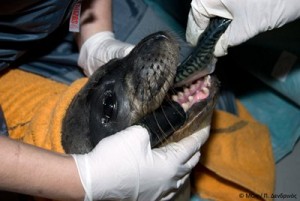Recent Publications
![]() Murphy S, Spradlin TR, Mackey B, McVee J and others. 2012. Age estimation, growth and age-related mortality of Mediterranean monk seals Monachus monachus. Endangered Species Research 16:149-163. [PDF 1.4]
Murphy S, Spradlin TR, Mackey B, McVee J and others. 2012. Age estimation, growth and age-related mortality of Mediterranean monk seals Monachus monachus. Endangered Species Research 16:149-163. [PDF 1.4]
ABSTRACT: Mediterranean monk seals Monachus monachus are classified as Critically Endangered on the IUCN Red List, with <600 individuals split into 3 isolated sub-populations, the largest in the eastern Mediterranean Sea. Canine teeth collected during the last 2 decades from 45 dead monk seals inhabiting Greek waters were processed for age estimation. Ages were best estimated by counting growth layer groups (GLGs) in the cementum adjacent to the root tip using unprocessed longitudinal or transverse sections (360 µm thickness) observed under polarized light. Decalcified and stained thin sections (8 to 23 µm) of both cementum and dentine were inferior to unprocessed sections. From analysing patterns of deposition in the cementum of known age-maturity class individuals, one GLG was found to be deposited annually in M. monachus. Ages ranged from 0.5 to 36 yr for females, 0.5 to 21 yr for males and 0.5 to 25.5 yr for individuals of unknown sex. The majority of seals (65%) were considered adults (≥4 yr), followed by juveniles (20%, <1 yr) and sub-adults (15%, 1−3.9 yr). Thirty percent of the aged sample had died from human-related causes, such as accidental entanglement in fishing gear and direct killings. A single-Gompertz growth curve was generated for both sexes using standard length data, resulting in asymptotic values of 212.3 cm for females and 221.8 cm for males. This study represents the first quantitative glimpse of sex-specific growth in monk seals and the age structure of dead individuals in this rare species’ core range.


 In 2010 and 2011 NOAA Fisheries staff began to observe a nine-year old monk seal, KE18, attacking newly weaned and juvenile seals at Kure Atoll in the NWHI; causing injuries including lacerations, scratches and puncture wounds on this critical component of the monk seal population. KE18 seriously injured 10 of the 13 pups and an additional three juveniles during the 2010 and 2011 field camps on Kure Atoll. When KE18 transited to Midway Atoll there were two unexplained deaths during his time there.
In 2010 and 2011 NOAA Fisheries staff began to observe a nine-year old monk seal, KE18, attacking newly weaned and juvenile seals at Kure Atoll in the NWHI; causing injuries including lacerations, scratches and puncture wounds on this critical component of the monk seal population. KE18 seriously injured 10 of the 13 pups and an additional three juveniles during the 2010 and 2011 field camps on Kure Atoll. When KE18 transited to Midway Atoll there were two unexplained deaths during his time there.